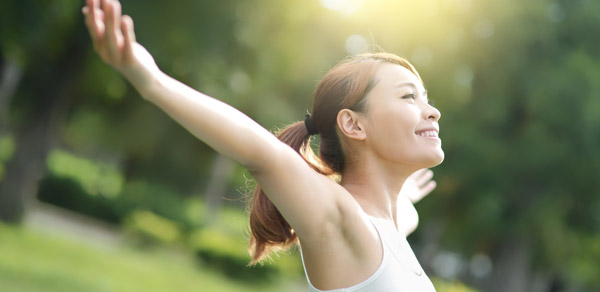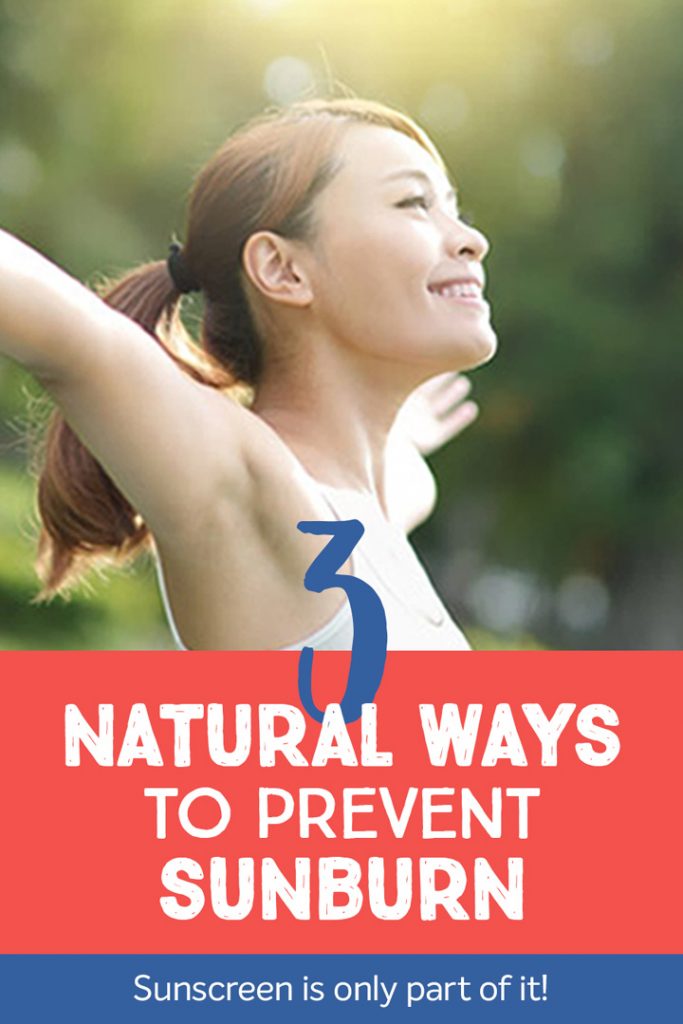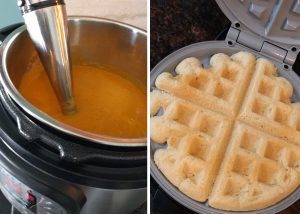Yes, sunscreen is necessary, and I will get to my recommendations, but did you know that there are other things you can do as well to make your skin less susceptible to sunburn?
I’m not a big fan of sunscreen all the time. The biggest reason is because most brands make my skin feel sticky and almost as if it was not allowing me to sweat, and I feel hot and constricted. Because of this, in the past, if I wasn’t planning on being in the sun too long, I would try to go without. And yes, I would burn. Over the past several years, I have adopted a clean, healthy diet, and have learned natural ways to help prevent sunburn. Good news is that I can now get away with a lot less sunscreen!
I’m fair-skinned with strawberry-blonde hair and blue eyes—pretty much the exact type you would think gets burned 5 minutes after walking outside. And actually, I used to—but not anymore! It’s not because I’m living in a cave somewhere or slathering myself with SPF 70 all day long either. In fact, I now only use sunscreen if I’m going to be in the sun for an extended amount of time or on vacation somewhere sunny!
After doing some research and putting 2 and 2 together, I believe for me it has been because of two main factors. Good nutrition and supplementing with astaxanthin. I will also cover what types of sunscreens to use for extended sun exposure.
My history to put it in context
So long story short. Several years ago, my husband and I cleaned up our diet in a major way. We mostly eliminated grains, legumes, sugar, processed seed oils, and processed foods in general. Life changing! My husband lost more than 70 pounds (easily) and I happily lost ten. Best part is that we felt great! With good, real-food nutrition I found that I don’t worry about my weight because it stays where it should, I have far less brain fog, my mood is amazing, my skin looks better, and a don’t get sunburned as easy. I have to admit I hadn’t expected that way my skin reacted to the sun would change! Healthy food can do amazing things!
I first noticed this few years ago in Cancun. After a few hours in the sun, I realized that I had not reapplied my sunscreen. This was Cancun in April—that means my skin had not seen the sun in over six months! I thought that I was in trouble and would have a REALLY BAD burn—you know, the kind that stings when you take a shower or expose it to temps over 75. The kind that wrecks the rest of your sunny vacation. But not at all—the next day it was just a little pink and it didn’t hurt at all. Within a day and a half it didn’t even look like a burn at all. It was tan. What?!! This had never happened! This was great! I was happy my skin wasn’t fried, but why?
So I thought about it. Was the sun not as strong as I thought? Come on, this is Cancun—that wasn’t it. I’m from Wisconsin. I have pasty-white skin. No way. Needed a better answer. I started thinking about what was different at this time compared to the past. I was using the same sunscreen I had used for the previous few years. The only thing that was different was the major change in my diet.
It makes sense. Sunburn is inflammation. The inflammatory response is even greater when we have chronic inflammation going on internally. While I have no official diagnosis or obvious symptoms of chronic inflammation, I ate a standard American diet of processed crap for most of my adult life, so I’m pretty sure that I had some level of inflammation going on without even knowing. This new-found side effect from a real food diet makes a lot of sense. It further goes to show you how food and nutrition affect EVERYTHING in our bodies, and that food really is medicine!
Nutrition
First, let’s talk about nutrition. Personally, I pretty much follow a Paleo/real food diet (about 90%). I eat lots of veggies, grass-fed/pastured meat and eggs, pretty much nothing that comes in a box, and very little dairy or grains (occasional corn tortillas or rice). I’ve mostly eliminated foods that cause chronic inflammation and replaced them with more nutrient-dense real food. I think that removing processed seed oils and sugar has made the biggest difference for me in terms of reducing inflammation and reducing my tendency to get sunburned.
Eliminating processed seed oils like canola, corn, soybean, and cottonseed oils is important for reducing systemic inflammation. These highly processed (and often rancid) oils are mostly polyunsaturated, and are very high in omega 6 fatty-acids which can encourage inflammation when consumed in large amounts. Increasing intake of Omega3 fatty acids also helps reduce inflammation in the body. Omega3s are found in fatty fish like salmon, tuna, and sardines, as well as grass fed meats. I have really noticed a difference since switching to healthy, saturated and monounsaturated fats like butter, ghee, lard, coconut, and avocado oil. These fats also contain vitamins A, D, E, and K which may also contribute to overall skin health.
Removing most sugars from my diet played a big role in reducing inflammation as well. Sugars, and refined carbohydrate foods like bread and pasta, cause a blood sugar roller coaster in your body which also leads to chronic inflammation. I found that limiting my sugar intake to occasional fruit and a little bit of honey or maple syrup has made a huge difference in my overall health. In addition to my skin not burning as easy, I also have fewer headaches and fewer general aches and pains. I also have more energy and my moods are much better. Decreasing sugar intake is one of the best things you can do for your body in general to reduce and prevent chronic inflammation.
Reducing inflammation can make a huge difference in the way your skin reacts to the sun. It makes sense to me now that what we eat has a direct effect on every aspect of our health including the skin. I personally feel better than ever, and I also love these cool, unexpected side effects like reduced sunburn! My skin is generally healthier and therefore it is better prepared to handle some sun exposure. It’s a cycle: good nutrition allows me to stay in the sun longer and get more vitamin D which adds to my good nutrition that allows me to stay in the sun… pretty cool, right?
Astaxanthin
The second thing that has added even MORE sun protection to my skin has been supplementing with astaxanthin. According to Nutrex Hawaii, a quality manufacturer of natural supplements, Astaxanthin is a naturally-occurring carotenoid pigment that is found in algae, selfish, and salmon. It is a powerful anti-oxidant. It is beneficial for faster muscle recovery after exercise; joint, tendon, and muscle health; eye and brain health; and skin protection during UV and sun exposure.
In the spring, I take astaxanthin to prepare my skin for summer sun, as well as a month or so before a sunny vacation. I have learned that it takes about 30 days to see the benefit of astaxanthin. After a few weeks of taking it, I notice a healthy, light pinkish glow to my otherwise pale skin. Pinkish in a good way, not red or flushed-looking in the slightest!
Astaxanthin really does work as an internal sunscreen. Even though my skin had an improved resistance to burning just from a nutritious diet, adding astaxanthin made a big difference as well. It is one of the few supplements that makes a noticeable difference for me. It is literally sunscreen that you eat! I love the internal protection I get from taking astaxanthin. I take 8–12mg each day starting about a month before summer sun, which is the recommended dose. I also start taking it 3 to 4 weeks prior to a sunny vacation! I would estimate that I can stay in the sun at least twice as long without burning as I could before! Now, I actually get a light tan over the course of the summer, which is a good thing—it’s the skin’s built-in way of regulating the effects of sun exposure.
Astaxanthin certainly adds a level of natural sun protection, but when I am on vacation or exposed to the sun for extended periods of time, I most certainly use sunscreen! We want some sun for getting them most bioavailable form of vitamin D, but we don’t want to burn!
Use sunscreen!
Some sun exposure is great, but you can get too much of a good thing! When you’ve had enough sun—that means before you get burned—try to find some shade, put on a hat, and cover your skin! When that’s not possible, or you will be in the sun for longer than you want, use a natural, mineral-based sunscreen. Look for ones made with zinc oxide for the best and safest sun protection. Carrot seed oil and raspberry seed oil are also effective natural sunscreens, but are very expensive, so it is not likely to find them in large amounts in most sunscreen products.
I avoid chemical sunscreens because I don’t want the chemicals getting absorbed by my skin. Some of the ingredients in sunscreens end up doing more harm than good (many are carcinogenic). They do protect from the burning UVB rays, but they usually don’t protect against the damaging UVA rays! Little known fact: UVA rays are the damaging rays, yet the SPF strength is listed for UVB (burning rays). This gives us a false sense of security because while we are preventing sunburn we are still damaging our skin!
I personally prefer a sunscreen containing zinc oxide and no chemical sunscreens because the zinc physically blocks both UVA and UVB rays providing complete protection. I also cover up with clothing and/or a hat when I’ve had enough (even better).
A few sunscreens I like are Beautycounter Countersun Mineral Sunscreen, ThinkSport SPF 50 Sunscreen, ThinkSport SPF 50 Kids Sunscreen, and Badger Balm Zinc Oxide Sunscreen SPF 30. Full Disclosure: I am a Beautycounter consultant, but I really love their Countersun Mineral Sunscreen, because it is effective (all of my recommendations are) and it absorbs nicely without leaving white residue!
So, in a nutshell, here are my 3 best ways to help prevent sunburn
- Eat real food.
- Eliminate processed food, seed oils (canola, soybean, corn, cottonseed)
- Reduce consumption of refined sugars and grains
Avoid processed food
- Consider supplementing with astaxanthin—it acts as an internal sunscreen
- Use a natural, mineral based sunscreen for extended sun exposure to protect from both UVA and UVB rays, and of course find some shade!
For more information check out these resources:
5 Simple Ways to Get Healthier Skin
Book:
Eat the Yolks, by Liz Wolfe (Has a great chapter about vitamin D and sunscreen)
Products:
Badger Balm Zinc Oxide Sunscreen SPF 30
ThinkSport SPF 50 Kids Sunscreen,
Beautycounter Countersun Mineral Sunscreen
Sources:
Astaxanthin: A Review of the Literature; Natural Medicine Journal
http/www.naturalmedicinejournal.com/journal/2012-02/astaxanthin-review-literature
__________________________
All content on CindyHilliard.com is for information purposes only and is not to be used in place of medical advice or treatment. Always seek the care of a medical professional if you have health concerns.
__________________________
Links on CindyHilliard.com may be affiliate links, which means that I may receive a small commission if a purchase is made by clicking a link, with no additional cost to you. I only share links to products that I truly use and recommend!
Cindy Hilliard Nutrition is a participant in the Amazon Services LLC Associates Program, an affiliate advertising program designed to provide a means for sites to earn advertising fees by advertising and linking to amazon.com






